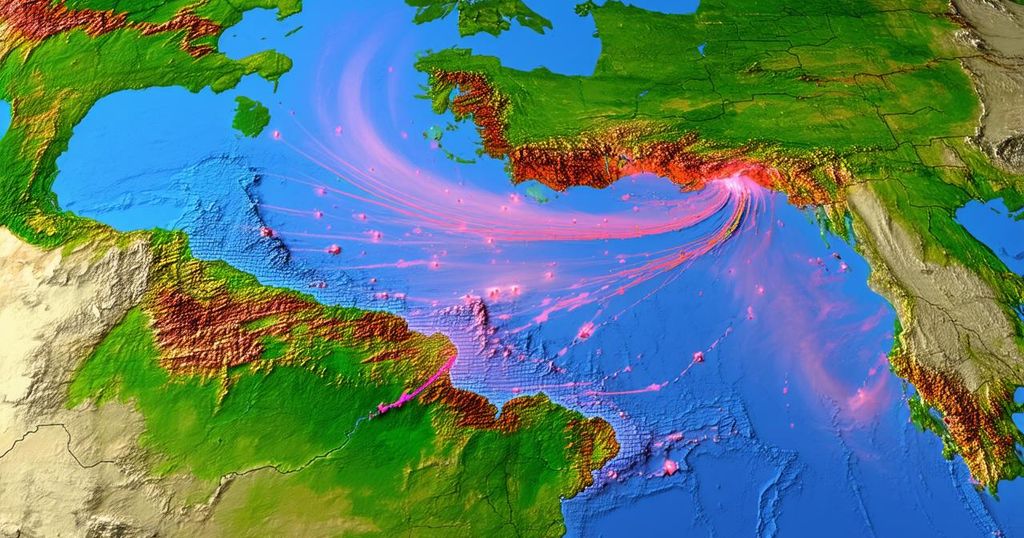An Examination of the Strongest Earthquakes Recorded in History
The strongest earthquake ever recorded was the Valdivia Earthquake in 1960, with a magnitude of 9.5. Other significant earthquakes include the 1964 Great Alaska Earthquake (9.2), the 2004 Sumatra-Andaman Earthquake (9.1), the 2011 Tohoku Earthquake (9.1), and the 1952 Kamchatka Earthquake (9.0). Each event had devastating impacts, prompting global advancements in disaster preparedness and response systems.
The strongest earthquake ever recorded is the Valdivia Earthquake, also known as the Great Chilean Earthquake, which occurred on May 22, 1960. It registered a magnitude of 9.5 and struck the Bio-Bio region of Chile, resulting in severe shaking that persisted for approximately 10 minutes. This catastrophic event sparked multiple tsunami waves that devastated coastal areas across the Pacific Ocean. The aftermath in Chile was dire, with an estimated 1,600 fatalities, around 3,000 individuals injured, and 2 million left homeless. Furthermore, the tsunami waves claimed more than 200 lives in Hawaii, Japan, and the Philippines. Additionally, the earthquake prompted the eruption of the Cordón Caulle volcano, exacerbating the destruction in the affected regions. Following closely is the Great Alaska Earthquake, which occurred on March 27, 1964. This powerful tremor, with a magnitude of 9.2, inflicted extensive damage in Anchorage and neighboring areas due to significant land subsidence and strong shaking. The earthquake generated a tsunami that reached coastal regions from Alaska to California. Despite the massive destruction, the relatively low population density limited the death toll to 131. The Indian Ocean was the site of another major seismic event on December 26, 2004, when the Sumatra-Andaman Earthquake struck with a magnitude of 9.1. This earthquake triggered one of history’s deadliest tsunamis, impacting over a dozen countries and resulting in the deaths of more than 230,000 individuals, particularly devastating coastal regions in Indonesia, Thailand, Sri Lanka, and India. The disaster prompted global initiatives to enhance tsunami warning systems and evacuation protocols. On March 11, 2011, the Tohoku Earthquake, measuring 9.1 in magnitude, struck near the east coast of Honshu, Japan. The earthquake’s intense shaking lasted for over six minutes and was followed by a catastrophic tsunami that inflicted extensive damage along northeastern Japan’s coast. Approximately 18,000 lives were lost, and the disaster led to the Fukushima nuclear plant meltdown, which had far-reaching implications for nuclear safety and disaster preparedness in the region. Lastly, the Kamchatka Earthquake occurred on November 4, 1952, with a recorded magnitude of 9.0. Despite being one of the largest earthquakes, its remote location limited casualties to an estimated 10,000 to 15,000 individuals. The accompanying tsunami reached the Aleutian Islands, causing substantial damage to Hawaii. Severo-Kurilsk, a town directly affected, experienced waves between 50 and 60 feet high, leading to significant loss of life among its residents. The survivors rebuilt their community at a safer elevation, serving as a stark reminder of the immense destructiveness of earthquakes, even in sparsely populated areas.
This article discusses the five most powerful earthquakes ever recorded, distinguished by their magnitudes. It is important to note that the focus is on the magnitudes of these seismic events rather than the extent of collateral damage or loss of life. Each earthquake highlighted has significantly influenced seismic research, disaster preparedness, and public safety measures in the face of natural calamities. Understanding these historic earthquakes allows for improved cautionary practices and better emergency response strategies worldwide.
In summary, the Valdivia Earthquake of 1960 remains the strongest recorded earthquake at a magnitude of 9.5, followed closely by major quakes in Alaska, Sumatra, Japan, and Kamchatka. Each event has incurred profound consequences, both immediate and long-term, reinforcing the necessity for robust preparedness measures against future seismic activities. These earthquakes serve as critical reminders of nature’s formidable power and the importance of advancing science and safety protocols in the face of such natural disasters.
Original Source: science.howstuffworks.com




Post Comment